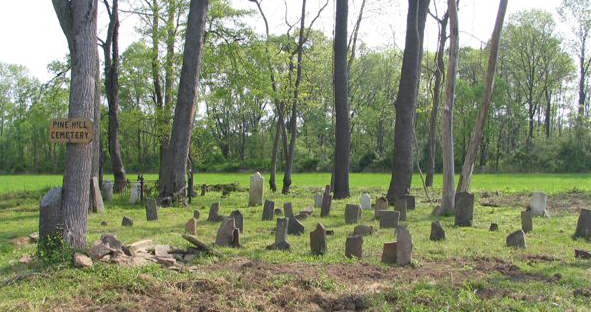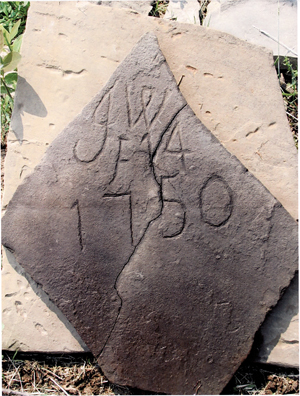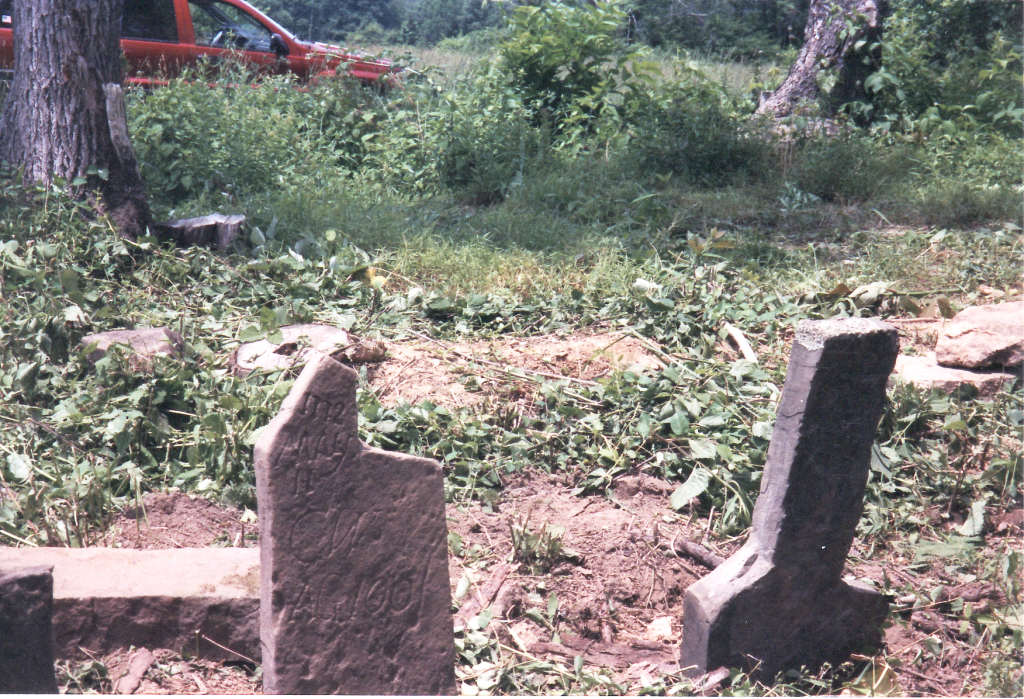
In 2009, I published an article about this interesting cemetery on the website The Delaware Township Post. This coming June, this cemetery will be the focus of a celebration; most of the original Williamson farm has been purchased from Bryce Thompson by the N. J. Conservation Foundation in partnership with the State of New Jersey, Hunterdon County and Delaware Township. The cemetery is part of this new addition to preserved lands in our town. I am delighted! Here is the article:
William Williamson was born about 1708 in Gravesend (Brooklyn) to Cornelis Williamson and Grietje Gulick. His great-grandfather Willem Gerritsen had emigrated from Holland to Bermuda, and then to Amersfoort (Flatbush) in New Netherland in 1659. About 1730-32, William Williamson married Patience Hull, the daughter of Samuel Hull and wife Margaret. Their first child Margaret was born about 1732.
In 1735, William Williamson bought a large tract of land from Tunis and Paul Amerman in Amwell (Delaware Twp.). This property extended north from Pavlica Road. The Williamson family remained there, with six more children born after Margaret. In 1742, William Williamson bought another large tract of land to add to his original purchase. In 1752, he was named an overseer of roads for Amwell Township.

The earliest stone found in the cemetery is “J W / F 14 / 1750.” Williamson researchers cannot identify who this might be. Perhaps it was a child of William and Patience Williamson who died young.
The next earliest stone is “AP 10 1765 W W.” It is generally agreed by Williamson researchers that this is William Williamson, the first settler. He wrote his will 0n January 20, 1764. It was not recorded until June 16, 1774, suggesting that he died close to that date, which is usually the case. But this family is different. His eldest son Cornelius was very reluctant to carry out the provisions of the will, which eventually led to a court battle that Dickens would have appreciated. In fact, court papers confirm that William Williamson did die in 1765; the stone sets the date at April 10th.
The next to be buried here, as far as we know, is William’s father. This stone was only recently discovered by Dot Williamson. It was lying about a foot underground. It reads: “May 11, 1772 C W AG 100.” Williamson descendants have concluded that this must be Williams’ father Cornelius Williamson, who died May 11, 1772 age 100. This is remarkable for two reasons. First, the Williamson descendants had been having a hard time locating this Cornelius, so discovery of this stone was a real breakthrough, and secondly, that he lived to the age of 100 in the 18th century. Most unusual. His son William was only 57 when he died.

The next earliest stone, “A.W. 1781 AP 24” {backwards 4}, belongs to one of the sons of William and Patience, Abraham Williamson, born about 1743. It is thought he might have had some kind of handicap, as his father left an extra £100 for him in his will and it appears he never married.
In December 1787, William’s wife Patience Hull died and was buried here. Her stone reads “P W.”
Later members of the Williamson family who are buried here are William (d.1848), Asher (d.1860), and Moykee (d.1868).
William Williamson,
died October 21, 1848, age 79-2-3.
He was the son of Cornelius Williamson and grandson of William Williamson and Patience Hull. He never married. I think he might be the “Uncle Billy” who used his 7-foot musket to shoot and kill a large panther on a farm on Reading Road. This story was told by Jonathan M. Hoppock in an article published in the Democrat in 1902.
Asher Williamson,
died May 28, 1860, age 83-1-3
Asher Williamson was the brother of William, above, and another son of Cornelius. He also never married, but had a very active and contentious life. He took advantage of gullible relatives to acquire rights in the estate of his grandfather William Williamson. He was sued for this in 1824, but it took until 1843 for the court to rule against him.
Moykee Williamson,
March 6, 1785-December 8, 1868, age 83-9-2
Asher Williamson’s sister Moykee Williamson was buried next to him. She also did not marry. She kept house for her brother Asher, who had left the bulk of his estate to her in his will.
One inventory of the Cemetery lists this stone: “R. W. 1899.” It is no longer to be found in the cemetery, and has not been identified.
In the 19th century other families began to use this plot. The earliest found was “W. S. died October 4, 1792.” The S is reversed. The name was probably William Sergeant. This makes him a contemporary of Charles, John and Joseph Sergeant of Sergeantsville, but I have not been able to link him to that family.
Another mystery is L. S. 1807. The father of Charles, John and Joseph Sergeant, Joseph Sergeant Sr., died without a will in 1807. The ‘S’ on this grave stone is written backwards. But there is no mistaking the L. It is not a J. So it probably isn’t Joseph Sergeant Sr. But who is it? There was a Loman Sergeant, born 1763, died 1852, who was a son of Joseph Sergeant Jr. Perhaps there was an earlier Loman Sergeant.
At least we can be clear about Charles Sergeant.
Charles Sergeant,
died April 11, 1833 in his 74th year. b.1760
Sarah Green Sergeant, widow of Charles,
died March 27, 1835
He ordered in his will that an iron fence be installed around the graves of his wife and himself. Charles Sergeant’s wife was Sarah Green, daughter of Samuel Green and Elizabeth Waterhouse, and granddaughter of Richard Green and Elizabeth Woolverton. The son of Charles and Sarah Green Sergeant was named Richard Green Sergeant, but he was always known as Green Sergeant, the name that attaches to the covered bridge today. But his grave is not here.
A short history of the Sergeant family would mention that Charles, John and Joseph Sergeant are said to have been storekeepers in Skunktown (later Sergeantsville) before the Revolution, that Charles Sergeant, born on March 30, 1760, enlisted in 1781 in the Amwell militia, and returned to storekeeping after the war. Charles began acquiring property in the 1790s, gradually building up his wealth. When the Opdycke family offered the mill property at the covered bridge for sale in 1805, Charles bought it and made improvements. The area around the mill and the bridge came to be known as Sergeant’s Mills. After his death in 1833, his executors had a lot of work selling off his many properties.
In a deposition in a court case involving the estate of Margaret Williamson Larew Hull, daughter of the original William Williamson, Charles Sergeant testified that he was Margaret’s nephew. I have never been able to determine how he was related to her. Perhaps someday the mystery will be solved.
There were two members of the Heath family buried in this cemetery. The Heaths owned large acreage north of the Williamson farm, between Locktown-Sergeantsville Road and Ferry Road. Buried here is M. Heath 1806 and J. Heath 1819. This is John Heath, born 1724, died March 11, 1819, and his wife Mary, born 1728, died 1806, maiden name not known. John Heath was one of the nine children of Andrew Heath (c.1695-1745) and wife Mary. I do not know when he moved from Amwell to Kingwood Township, but that is where he was living when he died at the age of 94. His obituary read: “Mr. John Heath, in the 94th year of his age. . . was esteemed as an useful and respectable man; he had led an active and temperate life, and it is believed that within the last year he could have walked from three to four miles per hour, for several hours in succession, without any unusual exertion.”
Mary Lake is buried here. She was born Mary Sergeant in 1765, sister of Charles Sergeant, and died age 48 on April 15, 1813. About 1790, she married Cornelius Lake, who owned the Gilde farm in Sergeantsville. Cornelius was Commissioner of Deeds for many years, and his name appears in hundreds of deeds for that reason. Cornelius Lake died age 80 in 1842 and is buried in the Lower Amwell Old Yard.
The latest stone to be found at Pine Hill belongs to Abraham Rounsavell, who died age 67 on Aug. 17, 1863. He never married. According to the Rounsavell Genealogy, Abraham was an invalid from birth. His father’s will, dated Jan. 14, 1839 when Abraham was 53 years old, stipulated that Abraham be cared for by the Executors of the will and that Isaac Huffman (one of the executors) be Abraham’s guardian.
Correction, 5/20/2013: I took the date 1853 from the Hiram Deats Inventory list at the Hunterdon Co. Historical Society. But today, while scrolling through Dennis Sutton’s excerpts from the Hunterdon County Democrat, I discovered that Abraham died on Aug 17, 1863, not 1853.
His parents were Isaac Rounsavel, who died in 1839 and is buried in the Sutton family burying ground, and Catharine Larew, who died on April 5, 1832 and is said to have been buried at Pine Hill, although her stone is missing. As a sidebar, I note that the Hunterdon Gazette reported on Jan. 7, 1829 that “Isaac Rounsavell lately delivered a Hog at the store of D. & P. Brewer, Head Quarters, in this township, which was about 20 months old, and weighed 680 lbs. He measured 6 feet 7½ inches in the girt before he was slaughtered, and 7 feet 11½ inches from the end of the nose to the root of the tail.”
Two other stones may be members of the Rounsavell family: C. R. and S x R.
One would expect other members of the Larew family to be buried here. I have already mentioned William Williamson’s daughter Margaret who married Daniel Larew (c.1720-1762). Their farm was on Reading Road, adjacent to his brother Moses Larew (1740-1797) and wife Urania Thatcher. Both farms backed up to Pavlica Road, just south of the Williamson farm. Another Larew, David (c.1740-1787) and wife Abigail Rittenhouse lived somewhere nearby, and the fourth brother, Abraham (1727-1806) and wife Mary (possibly Thatcher) owned the Donald Jones farm. There is a stone here that probably belongs to Moses Larew: M. L. There is also a stone that reads A. L. and A. Larowe, son. There are any number of possibilities for A. L. The name Abraham was a favorite in the Larew family.
The final mystery is a stone that reads “I.F. May 14 1831.” I thought perhaps it could have been Isaac Rounsavel, the F a mistake for R, and 1831 a mistake for 1839. But Isaac died on Dec. 28th, so there’s no question it is not the husband of Catharine Larew.
One possibility is John Furman (born 1755, died 1831, married Elizabeth Wildman). He owned the farm and farmhouse on Locktown-Sergeantsville Road where Plum Brook crosses. J’s were often written as I’s in the 18th and 19th centuries. However, the stone was broken in several pieces, so we can’t be sure that the inscription is correct.
In 1816, owners of the Williamson Farm in exchange for $6.40 conveyed enough land to John Sergeant, James Larue, Thomas Lake and Asher Williamson to enlarge the existing graveyard to a square of about a quarter acre, with privilege to build walls and maintain it. Oddly enough, none of these gentlemen (except Asher Williamson) are known to be buried in this cemetery, even though all were residents of Delaware Twp.
It is hard not to think that there are other stones buried a foot or more beneath the surface at Pine Hill. Dot Williamson and her husband Jack who live in Vermont have been making regular trips to the plot to beat back the weeds and banish the woodchucks, with the help of Helen Maliszewski of Cherryville. It is a never-ending task, but they have done a marvelous job. Perhaps they will soon be rewarded with another remarkable find.
I want to thank to Richard Williamson, Helen Maliszewski, Dot Williamson, Perry Streeter, and Marilyn Schmidt for their generous help with research for this article.
Mark Kreps
June 24, 2013 @ 10:39 pm
I am doing some research for my wife’s family, Janet Kreps. She descends from a Martin Johnson Williamson who was born in 1798 in New Jersey and parents were Cornelius and Mary Williamson. I was wondering if you ever came across Martin J. Williamson’s name? Martin ends up marrying a Margaret Feurt in Scioto Co. then proceeding to Delaware County and passing away in 1877.
No record of Martin J Williamson fighting in the War of 1812 that I could find.
Marfy Goodspeed
June 28, 2013 @ 2:24 pm
Dear Mark, Although I have a lot of Williamsons in my database, I do not seem to have the family you describe. Since Martin Johnson was an important resident of the Raven Rock area, one would think a Williamson named after him would have gotten on my radar, but the name is new to me. Perhaps this family belonged to the Somerset County branch instead of the Hunterdon County one. Sorry I can’t help.
Mark Kreps
January 12, 2014 @ 9:10 pm
Martin Johnson Williamson who was born in 1797 and from Somerset County, NJ. who eventually came to Delaware County, IN in the 1840’s and passed away by the late 1870,s. In order to find out who his parents were: I found on line a reference to Martin Johnson Williamson whose baptism occurred “28 Feb. 1798 at Six Mile Run, Franklin Township, Somerset County, New Jersey.” “Father Cornelius Williamson and mother, Mary Johnson” reportedly, according to Somerset County Hist. Soc. Somerville, NJ, in a publication listed as being, A. Van Doren Honeyman Sorerset Co. His. Soc. Publishers, Somerville, NJ, Magazine page: Vol. 8 p-264 Test: Six Mile Run Baptims 1743- 1805. Any info on Somerset County Williamson’s please let me know.
Cynthia Victor
December 4, 2015 @ 9:48 am
While researching the Hoagland side of my family I found that Henry Hoagland married Eleanor (Nellie) Hendrickson daughter of Gideon Hendrickson and Elizabeth Williamson. Elizabeth appears to be the daughter of Samuel Williamson and Eleanor Williamson Gulick. I think Eleanor may have been married to Gisbert (Gibert) Gulick first and Samuel secondly. Do you have any information on this families? It has been a confusing tangle as not sure if they were cousins and if she is connected to his brother Cornelius. Any help on the Williamson family greatly appreciated! They seem an interesting lot.
Marfy Goodspeed
December 4, 2015 @ 9:56 am
You are right about the Williamsons–a fascinating family. There’s so much to say about them! Unfortunately, I have no information on the Hendricksons or on this particular Henry Hoagland. I have five Henry or Hendrick Hoaglands in my database, but they’re all too old to be the one you are interested in.
Cynthia Victor
December 4, 2015 @ 10:15 am
Henry Hoagland was the son of Tobias Hoagland b. 1787 Neshanic, somerset Co. Tobias was the son of Abraham Hoagland b. 1731 married to Susannah Tobias Nevius b. 1761 Hunterdon Co. I have heard from other family members that there were a couple of Hoagland lines that are unrelated between Somerset and Hunterdon County. When visiting the Neshanic Cemetery it is confusing as there are several Hoaglands and there are not all connected.
David Heath, Pittsfield MA
January 30, 2016 @ 8:50 pm
Great article. I was excited to visit here in 2010 and see the gravestones of my ancestors John and Mary Heath.
Richard Wilson
July 18, 2016 @ 5:29 pm
Is there any record that the Pine Hill Burying Ground once belonged to the Jacob Smith farm (also referred to as the old Williamson farm)?
Marfy Goodspeed
July 19, 2016 @ 5:38 pm
Good question. I’ve got 21 Jacob Smith’s in my database, and no information on any of them owning the Williamson Farm, and hence Pine Hill Cemetery. No, wait a minute–Jacob B. Smith (1834-c.1918) bought the Williamson farm in 1868. He was the son of Mahlon Smith, Esq. and Jemima Barton. In 1872, he married Sarah Ellen Naylor. They had 4 children. In 1917, his heirs-at-law sold the farm to Henry J. Graven.